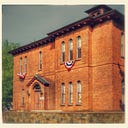Sankey’s Old Milk Bottle: “Hood’s Biggest Delivery”
By William F. Hanna
One day in January 1976, Carol Scofield, of Old Saybrook, Connecticut, was driving along Winthrop Street about two miles west of the Taunton Green when she spotted an aging, deteriorating structure beside the busy road. It was a 40-foot high rendition of a wooden milk bottle that appeared long overdue for demolition. But while some might have looked upon it as an eyesore, Ms. Scofield was enchanted. She was a devotee of Coney Island architecture, also known as Roadside Pop. These are buildings, many constructed in the 1920s and ’30s, which were designed as advertisements for themselves. One of the best-known was Hollywood’s Brown Derby restaurant, but at one time the countryside was dotted with diners in the shape of hot dogs, ice cream stands built to look like cones, etc. They are looked upon by some as oversized folk art, all part of a time when automobile travel was still seen as an adventure.

Ms. Scofield learned that the old milk bottle had been built in 1933 by Arthur Gagner as a place to sell his homemade ice cream. It was well constructed, with yellow pine boards fitted tongue-in-groove and sliding French windows. In its better days it had colorful awnings and a bright red tin cap sitting on top. Known to most Tauntonians as simply “the Milk Bottle,” it became a local landmark. Eventually Mr. Gagner sold it and the building passed into the hands of the Sankey family, whose home was nearby. They ran the business until 1967. By then, merchants on Winthrop Street, also known as Route 44, were feeling the negative effects of the expanding post-World War II highway system that was diverting travelers around, rather than through, Taunton. The Sankeys closed the business and the milk bottle entered what certainly seemed like its twilight years.
And then along came Ms. Scofield, who although she didn’t have a plan for the building, knew that it should be preserved. In February, Robert Campbell, architecture critic for the Boston Globe, became aware of the situation and brought public attention to the decaying bottle. “Nothing is sadder than a lonely, unwanted 40-foot milk bottle,” wrote Campbell. “Ordinarily it would have been torn down. But for some reason it survived.”

The bottle’s luck took a dramatic turn for the better later in the spring. In March 1976, the Boston Redevelopment Authority entered the story when it announced that it would try to raise the estimated $50,000 necessary to purchase the bottle and make it functional again. A month later, upon the request of the BRA, the Massachusetts Historical Commission sent staff members down for a site visit. After looking it over, they reported that the structure was indeed historically significant, both architecturally and for its historical associations, and the Commission endorsed the bottle as eligible for placement on the National Register of Historic Places. Even better, in June the BRA announced that HP Hood, a longstanding Bay State milk company, was willing to foot the bill and then donate the building as a Bicentennial gift to the city of Boston, in return for the right to operate the business as a frozen yogurt stand.
But nothing is easy, and the project hit a snag in the early summer. The BRA had at first planned to site the refurbished bottle in an empty corner of Boston’s City Hall Plaza, but strong objections from the Plaza’s architects caused the mayor’s office to nix that idea. Other proposed waterfront sites met with similar objections from area merchants and residents.
The location problem was finally resolved in August, when Robert Spock, director of the Boston Children’s Museum, stepped up and suggested that the bottle be placed on the Congress Street Wharf, near the Museum’s new home that was soon to open in a building adjoining the Museum of Transportation. That was an ideal location, and the following December, Sankey’s old milk bottle left Taunton forever and headed for the Squantum section of Quincy, where it would be refurbished as a working refreshment stand.
Five months and 80,000 Hood dollars later, the 40-foot bottle, standing tall, was ready. On April 20, 1977, in what the press called the “Great Bottle Sail,” the reborn 15,000-pound behemoth was placed on a barge and with great ballyhoo brought into Boston Harbor. Decrepit no more, it was saluted by two Boston Fire Department boats and assorted pleasure craft as it passed majestically through traffic toward the city’s waterfront. To one deeply impressed Boston newspaperman, it was even reminiscent of Cleopatra navigating the Nile.

Upon arrival at the Congress Street Wharf, the bottle was lifted from the barge and positioned in its new home. Someone figured out that if it were a real bottle, it could hold 58,620 gallons of milk. That would make it, said one company executive, Hood’s biggest delivery.
Sankey’s old milk bottle has stood adjacent to the Children’s Museum for forty-four years now, exactly as long as it lasted on Winthrop Street in Taunton. This past October, a renovation project was completed giving the bottle new awnings, windows and a refurbished lighting system. As summer approaches, it’s ready for yet another season.

Ed. Note: A similar milk bottle restaurant was built in Raynham, Mass. in 1925. At 56-feet high, it still stands at 785 Broadway (Rte. 138).
